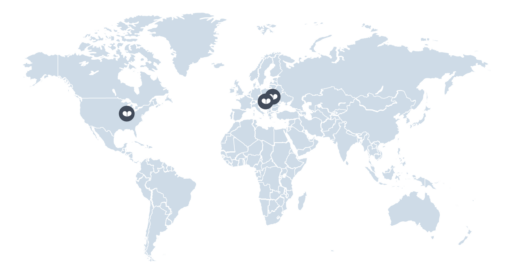Marketing teams around the world are always looking for ways to do their jobs better.
They try hiring more people, letting some go, using more tech – and sometimes using less – all to find the perfect way to work. But the answer they’re looking for might be simpler than they think: it’s about going Agile. Switching to an Agile way of working makes things smoother and more flexible for marketing teams. Today, we’ll show you how to do it with your marketing team.
What is an Agile Marketing Team?
An Agile marketing team applies Agile development principles to its work.
They focus on rapid iterations, flexible planning, customer feedback, and high responsiveness to change. An Agile marketing team adapts quickly to changes in the market and customer needs, employing Agile principles and methodologies originally from software development to optimize marketing processes.

The Difference Between Agile Marketing Teams and
Regular Marketing Teams
The difference between an Agile marketing team and a regular marketing team lies in their approach to planning and execution.
- Agile teams emphasize flexibility, continuous improvement, and customer-centric strategies, often working in so-called sprints to adjust to market changes.
- Regular teams typically follow a more traditional, linear approach to campaigns, with longer planning cycles and fixed schedules.
Benefits of Applying Agile Methodology to Marketing Teams
#1 Quick Market Response
Agile methodologies change how teams respond to the market. They quickly adjust strategies based on customer input, showcasing their adaptability. This flexibility is a core aspect of their strategy.
Originally rooted in project management, Agile now powers marketing adaptability. Teams skilled in Agile shine in fast-paced settings, adept at making necessary changes swiftly.
Agile emphasizes ongoing enhancement, transforming customer feedback into valuable insights. Then, these insights inform the development of products and services that surpass customer expectations.
Agile teams thrive on flexibility. Their secret? That special pursuit of excellence, through iterative learning and process improvement.
#2 Boosted Productivity in Agile Teams
Agile teams transform productivity. They break tasks into manageable chunks, pushing projects forward at an unprecedented pace. This method enhances efficiency across the board – even if people are resistant to change and new processes at first.
At the heart of Agile is the streamlining of processes – not only in software development but across various teams – that encourages tight-knit collaboration among team members. High-performing teams leverage Agile practices to ensure every sprint yields concrete results.
Within such a self-directed Agile approach, operations and technical teams operate in perfect sync. Development is driven by user stories, aiming to produce functional software that aligns with business requirements. Regular releases and thorough quality checks reduce errors and prevent project delays. Productivity is skyrocketing.
#3 Quality Focus
In Agile organizations, excellence is not a choice. It becomes standard.
It sets the stage for high-performing teams to do their best.
One of the common characteristics of Agile is that it ensures quality, making it a core aspect of every project. This commitment to excellence is evident in how Agile teams operate, consistently delivering work that goes beyond the basic requirements or business needs.
Feedback loops and frequent quality assessments play a huge role in fine-tuning strategies, ensuring that high standards are not only aimed for but achieved. This dedication to quality in each process leads to better results.
The importance of maintaining high quality permeates every part of an Agile project. Whether it’s developing new software or crafting marketing messages, an Agile team is always looking to improve their output. Iteration after iteration, they uncover improvements and innovations that drive their work forward.
It’s in their DNA.
#4 Teamwork Makes Dreams Work
Agile breaks down silos and improves collaboration.
The Agile approach is all about working together.
People from all parts of a project team up, breaking down those old walls that used to keep ideas from flowing freely. This togetherness is a big deal in the Agile world, where the focus is on people and better collaboration rather than sticking strictly to plans and tools.
Everyone – whether they’re writing the code for a brand new functionality, managing the work, or making sure everything runs smoothly – gets in on the action together. This teamwork goes way beyond just fixing mistakes.
It’s about creating something awesome by combining everyone’s strengths. Agile teams are extremely good at this, mixing the know-how of everyone involved to make projects really take off. This leads to coming up with even more ideas and exciting ways to solve problems.
Agile team members collaborate not only on ideas and solutions, but also perspectives – all for better team performance and a common goal.
#5 Planning Flexibility in Agile Development
In Agile teams, being flexible with plans is key.
This means they can change their plans quickly and smoothly when they need to. Since they’re always ready to take on new chances without getting scared, they keep moving forward, no matter what comes their way.
Agile methods help teams work together better and make great things. Everyone in the team knows how to shift gears fast. This makes sure they can keep up with new iterations – and still do a great job with the current ones. Change incoming? No hassle, no trouble – they just regroup and tackle any challenge that pops up.
#6 Customer-Centric Approach
Making customers happy is a big deal in Agile development. Teams always listen to what customers say they need or want. This way, they make sure that with every update or new version, they’re giving customers exactly what they’re looking for. The natural outcome here is increased customer satisfaction.
Everyone on the team wants to dig deeper into customer feedback. They all work together to make software that really helps and pleases people. This type of teamwork is a key part of Agile, helping to create great products that meet all the important needs.
Agile teams are all about getting better all the time – and customer feedback is invaluable here. They use customer comments as a guide to improve their work.
Since most Agile teams stay flexible and are quick to respond, they can keep up with what customers need without getting sidetracked. An Agile team works in a smart, organized way that leads to awesome and constantly improving products – and very, very happy customers.
How to Build an Agile Team in Your Marketing Department
Step 1: Learn and Understand the Framework
Understanding the core ideas of Agile sets the foundation for everything that follows.
To start building an Agile team in your marketing department, the first step is really getting to know what Agile is all about. Think of it like learning the rules of a new game. Agile isn’t just a set of rules, though – it’s a whole new way to play the game of marketing.
Start by looking into the Agile methodology. It covers all the big ideas behind Agile, like being ready to change plans quickly, listening to what customers say, and always trying to get better at what you do. These ideas are part of something called the Agile manifesto, the playbook for Agile teams.
Imagine trying to row a boat where everyone is rowing at a different pace or in a different direction.

You wouldn’t get very far, right?
That’s why in the Agile process, making sure that every team member, from developers to marketing folks, and even the board, understands and works toward the same goals is super crucial.
And this way, everyone knows why you’re doing things a bit differently and how their work helps the team succeed. Learning about Agile is kind of like preparing for a journey. You need to know where you’re going and how to get there.
Step 2: Set the Purpose, Metrics, and Goals
This step is about figuring out what success is, and how to measure it – so that everyone’s efforts are pushing in the right direction. While every team might pick slightly different things to measure, there are some common yardsticks they often use: workflow efficiency, cycle time, and throughput.
Workflow efficiency is all about understanding the balance between the time your team spends actively working on tasks versus waiting for something else to happen. This metric helps teams see how much of their time is productive and how much is spent waiting. It also comes in handy for those who deal with a lot of different requests from different parts of the organization. Checking how efficiency scores over time, teams can spot trends and figure out how to reduce waiting times, making it easier to hit their targets.
Cycle time gives a view from the customer’s perspective on how long it takes for the team to deliver results. It tracks how long it takes for a task to go from start to finish. If the team works more behind the scenes or relies on others to get their work out, cycle time can show how quickly they manage to get things done. With this metric, it’s easier to assess the team’s speed, responsiveness, and overall performance.
Throughput looks at how much the team gets done over a certain period, concentrating purely on the amount of work completed. Unlike efficiency or cycle time, throughput is all about quantity. It tells you how many tasks your team can handle in a set time frame.
When you look at these metrics together, they paint a full picture of a team’s performance.
High efficiency and low cycle times usually mean the team can do more work in less time.
Step 3: Identify Members and Their Roles
Building an Agile marketing team means bringing together a group of skilled individuals who can cover all the bases, from planning through executing to measuring success.
Here’s a look at the key members and their roles in a cross-functional, Agile team. They can vary from team to team, but in principle, the team includes:
- Marketing Owner: This person keeps the team oriented on business goals. Similarly to a product owner role in software development, the marketing owner prioritizes tasks based on customer needs and business value, so that the team works on what matters most. They are responsible for communication, adjustments, and aligning all marketers.
- Scrum Master: Acting as a facilitator, the Scrum Master helps the team stay true to Agile principles. They usually remove obstacles, support continuous improvement, and facilitate smooth collaboration within the team.
- Development Team Members: In an Agile marketing context, these are the creatives, analysts, and strategists who develop the campaigns. Their work is “working software” in Agile software development, as they create the output that drives business results. “Development” refers to the entire process.
- Ops Team Members: Operations teams work behind the scenes and Agile processes to ensure campaigns run smoothly. They might handle technical aspects, including website updates and data analysis, to support delivery and improvement.
- Project Managers: They oversee the project’s progress, making sure the team meets requirements and sticks to the schedule. Their role involves coordinating with other teams so that all parts of the project align with the Agile operation.
Step 4: Pick Agile Techniques to Foster Collaboration
You’ve added some people to your team – and now, you should tell them how they should collaborate. The good news is that Agile teams collaborate using various techniques and methods, and you can either pick one or two of them OR use them interchangeably. You can choose from, e.g.:
- Daily Standups: A quick, daily meeting where teams share progress, plans for the day, and any obstacles they’re facing. This keeps everyone informed on each next iteration.
- Sprints: Short, focused periods of work, typically 1-4 weeks, where the team commits to completing a specific set of tasks or objectives. Sprints usually help in managing workload and priorities effectively.
- User Stories: Simple descriptions of a feature or requirement from the perspective of the end-user or customer. With user stories, the team’s work is directly tied to customer value. For example, a user story might state, “As a young professional, I want to receive personalized career advice so that I can make informed decisions about my career path.” This story could lead an Agile marketing team to develop a series of targeted content pieces to address that particular story (need).
- Retrospectives: An umbrella term meaning meetings held at the end of each sprint to discuss what went well, what didn’t, and how the team can improve in the next sprint. This builds a culture of continuous delivery and improvement, not just fixes.
- Kanban Boards: Visual tools to track work progress, often divided into columns like “To Do,” “In Progress,” and “Done.” Kanban boards provide a clear overview of workload and progress – and can help avoid scope creep.
- Backlog Grooming: Regular sessions to review and prioritize the backlog (list of pending tasks).
- Pair Work: Two team members from the same department, working together on a task to share knowledge and reduce bottlenecks.
- Cross-functional Workshops: Workshops that involve team members from different functions to brainstorm, plan, or solve problems together.
These are the basics. But, according to Agile Sherpas’ report, there are even more methods to get inspired by.
Step 5: Use Tools for Better Operations
For improved collaboration in your Agile marketing team, using the right set of tools can make a big difference.
Here’s a quick overview of the types of tools that can help:
- Project management tools to keep your projects on track, helping everyone know what’s due and when. They’re great for planning all the moving parts of your marketing campaigns.
- Communication tools to keep the team connected, whether working in the office or remotely. Quick chats, video calls, and everything in between so no one misses out on important updates.
- Collaboration platforms to make it easy for team members to work together on documents, presentations, and other creative materials in real-time.
- File sharing services to share and keep all your important files in one place, accessible to anyone on the team whenever and wherever they are.
But you can also use one tool that combines many of them instead…
Step 6: Leverage Marketing Resource Management Software
As we mentioned, building an Agile team in marketing is all about being quick, flexible, and smart with your projects. To do so, you need to fine-tune not only your strategy or approach but also your tech stack.
Imagine your team as a group of pilots ready to fly high and fast, but they need the right cockpit to control their flight. And now, think of MARMIND as the high-tech cockpit for your marketing team’s airplane, to help everyone fly smoothly and reach their destinations faster.

When your marketing team gets bigger, things can get tricky, kind of like flying in stormy weather.
There are so many tasks to manage, from planning cool campaigns to chatting with your team and keeping track of how well your ads are doing. MARMIND is like the ultimate pilot’s dashboard, giving your team one place to manage and integrate everything.
Less time figuring out how to work different gadgets, more time soaring through your projects.

MARMIND helps large marketing departments manage the complexity of their day-to-day, letting everyone do what they do best: creating awesome marketing that takes your brand higher.
Step 7: Tackle Feedback and Reporting
Feedback and updates help high performing Agile teams stay sharp and make sure their work really hits the mark.
Feedback Loops: Agile teams love getting feedback. Actually, they breathe it. Getting thoughts and ideas from everyone helps the team stay flexible and avoid going off track.
Reporting: Sharing progress helps everyone understand what’s going well and what needs more work. It’s about showing off the good work the team has done, how they solved problems, and what they learned, so they can use these insights for their next challenge.
Testing: Testing is really important in Agile teams. It gives quick feedback on whether Agile operations work well. This helps the team find ways to add new features and make things better.
For example, the team hypothesizes that personalizing the email subject line will lead to a higher open rate. They decide to test it by creating two versions of the email. The personalized one delivers better results, so the team decides to change their internal guidelines for email marketing campaigns.
Self-Organizing Teams: Agile teams manage their own work, which makes feedback and sharing updates even more important. This freedom lets them use feedback to make smart choices and keep their work fun and interesting.
Over To You
Does your team have to go Agile to thrive? They DON’T have to. But they should! Adopting an Agile approach, grounded in Agile principles and operations, transforms groups into high-performing teams. Agile creates a dynamic environment where every team can excel, making agility not just beneficial but essential. This, naturally, translates into higher productivity and better performance – so why don’t you give it a go?










